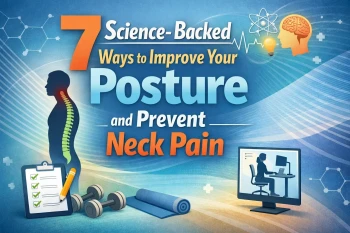
Can Cervical Spondylosis be Cured Permanently?
Cervical spondylosis is a common condition related to aging. During cervical spondylosis, the joints and discs in your cervical spine (neck area) is affected, causing the wear and tear of cartilage and bones. Cervical spondylosis is also known as osteoarthritis or neck arthritis.
Understanding Cervical Spondylosis
Cervical spondylosis can affect a person’s everyday life while others may not even know they have it. This condition affects more than 90% of those ages 60 and older, but may affect much younger age groups as well. It is important to pay attention to symptoms your body experiences to help spot if you have cervical spondylosis.
If you have suffered an injury or additional strain from work or hobby, it doesn’t hurt to make sure you get checked out in case you may not feel cervical spondylosis coming on.
Cervical Spondylosis Symptoms
Some of the symptoms for cervical spondylosis include the following:
- Pain increased while standing, sitting, coughing, sneezing, or tilting the neck
- Pain around the shoulder blade
- Pain along the arm and in the fingers
- Muscle weakness
- Stiff neck that becomes worse
- Tingling or numbness in the shoulders or arms and sometimes legs
- Headaches mostly occurring in the back of the head
Most individuals who have cervical spondylosis do not experience significant symptoms and the symptoms of cervical spondylosis may be sudden or develop gradually. Less common symptoms, however, include a loss of balance or loss of bladder or bowel control. If you are experiencing these less common symptoms, it is recommended to seek help immediately.
Cervical Spondylosis Causes
While cervical spondylosis is often related to aging, there are other causes of cervical spondylosis:
- Dehydrated Spinal Discs - Over time, the pad-like cushions between your vertebrae can begin to dry out and cause your bones to rub together. It can be painful, and this process can start to happen to those in their 30’s.
- Injury - Injuries to the neck due to whiplash or force put onto the area could cause cervical spondylosis by accelerating the aging process as this area weakens.
- Herniated Discs - Discs in your spine can develop cracks that lead to leaking the cushioning material. The material leaking can press on the spinal cord and nerves and cause arm numbness or pain.
- Bone Spurs - Overgrowths of bone occur when your body tries to make your spine stronger; however, the extra bone could apply pressure on delicate parts of your spine, such as the spinal cord and nerves.
- Overuse - Repetitive tasks can put additional pressure on the spine and cause early signs of wear and tear. These tasks could be from your occupation or a hobby that involves lifting heavy objects or repetitive movements. Even if you are sitting up at an office job for long periods of time where the neck is held in the same place or if it stays in an uncomfortable position during reading or phone calls, it can cause it additional stress.
- Ligament Stiffness - Over time, the cords that connect your spinal bones will become stiffer and limit your neck’s range of motion – making it feel tight.
Cervical Spondylosis Causes in Adults
Most causes of cervical spondylosis in adults would be due to overuse or aging. Our daily habits and occupations greatly affect how we use our neck and our habits can result in speeding up the aging process.
As we get older, it is important to continue to take care of our bodies and most adults keep working or doing tasks that adds to the pressure put on their bodies instead of taking the time to treat them.
Cervical Spondylosis Causes in Children
The most common cause of cervical spondylosis in children may be associated with injury or instabilities in the upper cervical spine. Contact sports and other activities where a child may fall or experience whiplash from play could result in harming the neck area.
It is important that is a child is showing signs of pain in their neck to have them looked at before it worsens over time. If left untreated, it could cause many complications for them later depending on how severe the injury was.
What to do About Cervical Spondylosis
Cervical spondylosis is often treated by the symptoms rather than its cause. The most known treatments are nonsteroidal anti-inflammatory drugs, corticosteroids, muscle relaxants, anti-seizure medications, antidepressants, and, if severe, surgery.
While these can help with some of the pain, they do not help the body repair and heal the parts that are injured from having cervical spondylosis.
What most do not know is that your body can repair itself through signals passed back and forth between the brain and body; this is what the brain stem is for. When the brain stem is compressed by an upper cervical bone of your spine, it can distort this communication and apply pressure on the nerves.
This causes your soft muscles and ligaments surrounding the misalignment to inflame and weaken. If left untreated, the body’s current state worsens over time – still becoming weaker and unable to repair.
This is where upper cervical adjustments come in, to help take the pressure off the brain stem and bring back your body’s ability to repair itself like it was made to do.
Chiropractic Cervical Spondylosis Diagnostic
If you feel you are experiencing cervical spondylosis, an upper cervical chiropractor can analyze how severe the misalignment is and how it is affecting your body. Unlike general chiropractic, an upper cervical chiropractor focuses on the upper cervical spine that protects your brain stem.
They are professionals in how misalignments affect the body’s nervous system, how it causes many different complications throughout the body, and how corrections enable the body to repair itself back to health.
Scans, discussion of your lifestyle and past injuries, and analyzing your range of motion will give off signs of how the misalignment is affecting your body, how it may have happened, and how long it has been a problem.
Chiropractic Treatment for Cervical Spondylosis
Upper cervical adjustments are gentle, precise, and safe for any age. As soon as an adjustment is made to correct a misalignment, the pressure placed on your brain stem is removed and the brain to body communication begins to flow properly. Right away, the body begins to work and doing what it can to start the healing process.
Depending on the severity of your case, you may undergo a few adjustments before the body is able to grow strong enough to hold the upper cervical spine in place. If you have had this misalignment for quite some time, the muscles and ligaments might be incredibly weak.
The goal of the upper cervical chiropractor is to keep correcting the misalignment as the body heals so the soft tissue can become strong enough to hold the correct alignment on its own.
Patients who have tried prescribed meditations and surgeries still had astonishing results from upper cervical adjustments. Unlike other treatment methods, upper cervical chiropractors look to focus on the cause of your pain rather than treating you on your symptoms. Upper cervical adjustments are also known to be successful in helping your body repair and grow stronger.
If you are experiencing cervical spondylosis, upper cervical could be the natural alternative your body needs.
If so, we would like to invite you to accept our invitation for a free 15 minute phone consultation to speak with one of our upper cervical chiropractic doctors where you can ask any questions you may have too decide if an exam or care might be right for you.
You can click the Contact Us link on this page, or alternatively give us a ring at the office at (843) 225-5855.







Leave a comment